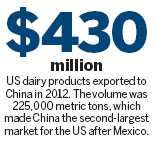 Regulators in China and the United States have resolved a nearly three-year dispute over health and sanitary certification of US dairy exports, ensuring continued shipments to a fast-growing market.
Regulators in China and the United States have resolved a nearly three-year dispute over health and sanitary certification of US dairy exports, ensuring continued shipments to a fast-growing market.The two countries had been negotiating a new certificate since China implemented numerous changes to its food-safety rules in 2010. In the intervening years, China kept its markets open to US exports under the expired dairy certificate while talks toward a new one progressed.
"Because of the complexity and just the logistics of negotiation, it often takes what appears to be a long time to come to agreements in these types of negotiations.
The new certificate was agreed to in late December and is now in use," said Hakim Fobia, a spokesman for the USDA's Agricultural Marketing Service.
"China has been a good trading partner for dairy in recent years," said Fobia, adding that the new certification regime should help the volume and value of US exports to increase.
"Although there never was a market closure, some Chinese buyers were hesitant to source from US suppliers while the risk of market closure during negotiations was possible," he said.
Uncertainty that buyers in China wouldn't be able to extend current deals at favorable prices was "the biggest impact" of the certification issue, said Alan Levitt, a spokesman for the US Dairy Export Council, which represents milk producers and dairy cooperatives.
One example is cheese, of which the food-service industry requires a consistent supply from a reliable seller, Levitt said.
"As China's food-service industry grows, there is certainly a greater demand for cheese, but I think some of the buyers were a little bit leery of buying from the US until we had this thing worked out," he said.
According to the USDA, $430 million worth of dairy products were exported to China in 2012. The top goods were lactose ($118 million), whey protein concentrate ($108 million), dry whey ($66 million), skim-milk powder ($42 million) and cheese ($37 million).
Levitt said US exports increased even during the certification talks because Chinese demand is strong and its domestic supplies can't keep up with consumption.
Also, many buyers are seeking to diversify their supplies so they aren't dependent on any one region of the world if shortages arise.
"However, getting the paperwork done was certainly a necessary thing, since the resolved certificate would give buyers more confidence, and I would expect volumes to increase over the next few years," the trade group spokesman said.
"I think the US dairy industry recognizes that if we want to continue growing as an industry, the market has to be overseas, and China, of course, is the big one," Levitt said.
The volume of US dairy exports to China has been rising steadily. The value of those exports fell in 2009 due to weak prices but has generally increased, said Ed Jesse, emeritus professor of agricultural and applied economics at the University of Wisconsin-Madison.
"As the Chinese population increases adoption of dairy products in their diet, they will want even more," he said.
"There is no inherent advantage to US dairy imports relative to imports from other major suppliers" such as New Zealand or the European Union, Jesse said. "But I believe there is an advantage to China in importing dairy products rather than attempting to become self-sufficient."
China was the No 3 market for US dairy exports by value in 2012 and the second-biggest as measured by volume - 255,000 metric tons, nearly 100,000 tons more than Canada and only 150,000 less than Mexico.
"The numbers speak for themselves, but it does not appear that the certificate issue had much of an effect. China will buy from the least expensive source, and that may not be the US," Jesse said.
"The US is not usually the least-costly supplier. There is the added question of milk production prospects in the US in the near term due to drought conditions continuing. I expect total US dairy exports to be smaller in 2013 and perhaps 2014."





